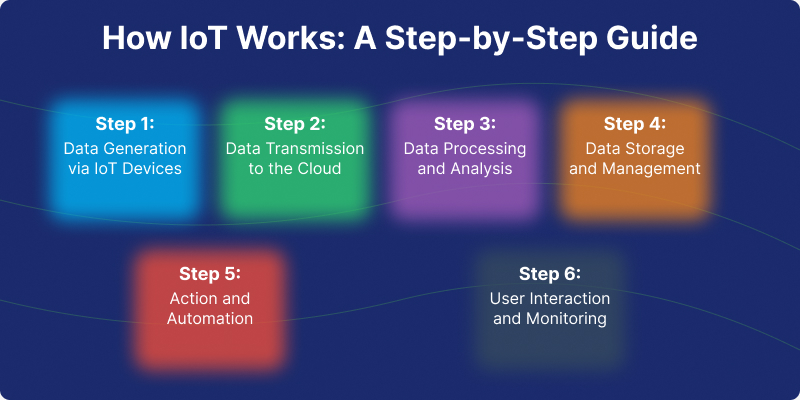
The Internet of Things (IoT) is revolutionizing the way we interact with technology by connecting devices and enabling them to communicate seamlessly. From smart homes to industrial automation, IoT is reshaping industries and daily life. In this blog, we will explore how IoT works step by step, with a clear diagram to illustrate the process.
Step 1: Data Generation via IoT Devices
The foundation of IoT is devices equipped with sensors, actuators, and connectivity features. These devices collect data from their surroundings, such as temperature, motion, humidity, or GPS location. Examples include smart thermostats, wearable fitness trackers, and industrial sensors.
Step 2: Data Transmission to the Cloud
Once IoT devices collect data, they need a way to transmit it for processing. This is done through various communication technologies, such as:
Wi-Fi: Common in smart home devices
- Bluetooth: Used in short-range communication like fitness bands.
- Cellular Networks (4G/5G): Ideal for IoT devices in remote locations
- LPWAN (Low Power Wide Area Network): Suited for large-scale industrial IoT
- Satellite Communication: Used in remote areas without traditional networks
Step 3: Data Processing and Analysis
The transmitted data reaches cloud-based platforms or edge computing systems, where it is processed. Advanced analytics, machine learning, and artificial intelligence (AI) help make sense of the raw data. This stage enables devices to generate insights and make real-time decisions.
Step 4: Data Storage and Management
Processed data is stored in cloud databases or local servers for future analysis and decision-making. IoT platforms like AWS IoT, Microsoft Azure IoT, and Google Cloud IoT help manage and secure this data.
Step 5: Action and Automation
Based on data analysis, IoT systems trigger actions. This can be automated or require human intervention. Examples include:
- Smart home automation: Adjusting temperature when occupants leave the house.
- Industrial automation: Detecting machine faults and initiating maintenance.
- Healthcare applications: Notifying doctors of abnormal patient vitals.
Step 6: User Interaction and Monitoring
Users can interact with IoT devices through apps, web interfaces, or voice commands. Dashboards and analytics tools provide real-time monitoring, alerts, and control options.
IoT Architecture Diagram
Below is a simplified diagram illustrating how IoT works:
[IoT Devices] → [Connectivity] → [ Cloud Processing ] → [Data Storage] → [Action & Automation] → [User Interaction]
Conclusion
Understanding how IoT works step by step is crucial for leveraging its full potential. From data collection to automation, IoT streamlines operations and enhances convenience across various industries. As technology evolves, IoT will continue to drive innovation, making our world smarter and more connected.